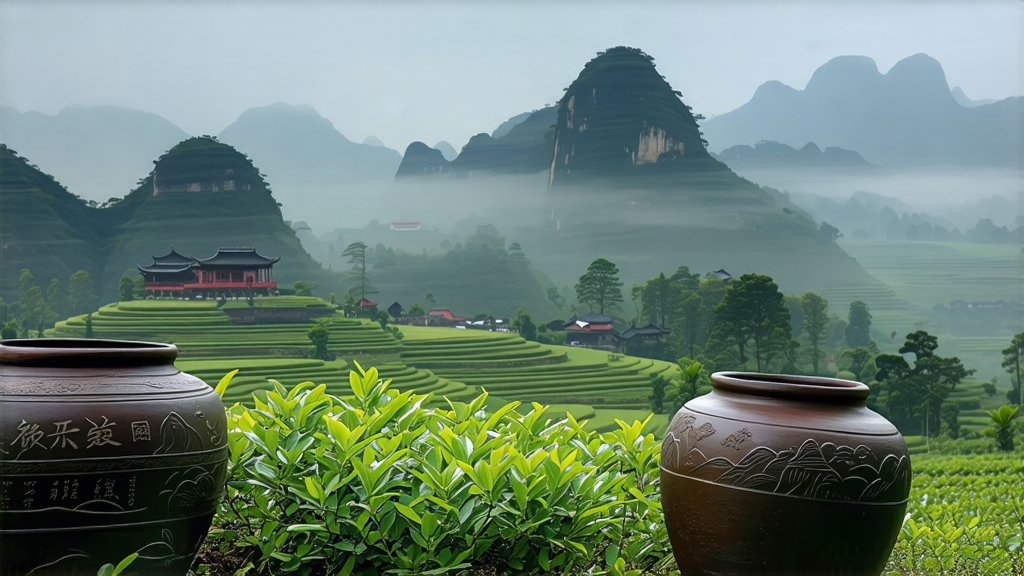
Tucked away in the humid, subtropical folds of southern China’s Guangxi Zhuang Autonomous Region, Liu Bao tea has spent four centuries quietly maturing in dark clay jars, waiting for the rest of the world to notice. To most Western drinkers “dark tea” still means a mug of English Breakfast left too long on the counter, yet in the lexicon of Chinese tea Liu Bao belongs to the hei cha (黑茶) family—literally “black tea,” but fermented rather than oxidised, a category that ripens with age like wine rather than fading like green tea. If puerh from Yunnan is the celebrated emperor of post-fermented teas, Liu Bao is the hermit-scholar who once advised the throne, equally wise but content to watch the mist roll over the Wuzhou valleys.
History: from border garrison to maritime silk road
The name Liu Bao simply means “six forts,” a reference to the six defensive outposts established during the Ming dynasty along the trade route that skirted the southern edge of the Dayao Mountains. Caravans of horses, copper, and tea moved southward to the port of Guangzhou; Liu Bao leaf, compressed into 40 kg bamboo baskets, was the currency that paid for soldiers’ rice and bartered for Burmese jade. By the Qing era the tea had sailed onward to Southeast Asia, where tin miners in Kuala Lumpur and betel-chewing grandmothers in Penang discovered that a cup of Liu Bao settled the stomach after a greasy hawker breakfast and cooled the body in equatorial heat. In 1801 the Jiaqing Emperor listed “Cangwu Liu Bao” as one of the 24 imperial tribute teas, and for the next century the baskets continued their journey—upriver on the Xunjiang, overland on the Tea Horse Road, and finally across the South China Sea on junks whose holds smelled of camphor, clove, and fermenting leaf.
Micro-terroir: why Wuzhou tastes different
Liu Bao is made only in the narrow granite valleys around Wuzhou city where three micro-climates converge: monsoon clouds trapped by the Nanling range, warm days and cool nights created by the Xunjiang and Guijiang rivers, and a soil layer rich in quartz and manganese washed down from the Dayao peaks. The indigenous large-leaf cultivar—Camellia sinensis var. sinensis f. pubilimba—carries an extra whorl of down on the underside of each leaf, trapping humidity that encourages the yeasts and molds responsible for post-fermentation. Locals insist that the same leaf taken 50 km east loses its ability to develop the prized “betel-nut” fragrance, the mysterious note that hovers between orchid, camphor, and the peppery snap of Areca catechu.
Craft: the alchemy of wet piling under banana leaves
Although Liu Bao is sometimes marketed as “raw” (sheng) or “ripe” (shou), the distinction is less binary than in puerh. All Liu Bao undergoes a unique Guangxi version of wo dui—wet piling—but for varying lengths of time. The process begins on the day of Qingming when pickers pluck one bud with the first three leaves, allowing a four-hour roadside wither so the leaf loses 15 % of its weight while still warm from the mountain sun. The leaf is then wok-fired at 280 °C for exactly 90 seconds, a shock that fixes the green colour yet leaves the central vein pliable enough to survive the coming ordeal.
Next comes the bruising: barefoot workers trample the leaf in knee-deep bamboo troughs, turning it every five minutes so the edges crack but the leaf remains whole. The bruised leaf is piled 70 cm deep on a raised slate platform, covered with freshly cut banana leaves, and left to ferment for 20–45 days depending on the master’s reading of ambient humidity. Inside the pile thermophilic bacteria (Bacillus subtilis, Aspergillus niger) raise the core temperature to 62 °C, while the banana leaf exudes a waxy enzyme that softens the tannic edge and seeds the future cup with hints of jackfruit and dried longan. When the pile exhales the unmistakable scent of rain-soaked earth and cracked betel nut, the tea is spread under the sun for one brief afternoon, then immediately steamed and pressed into 500